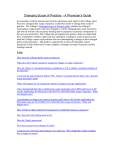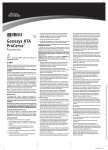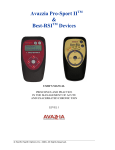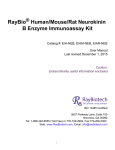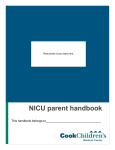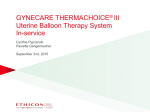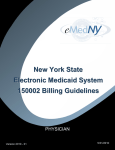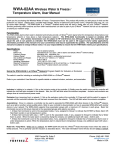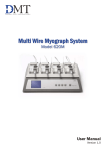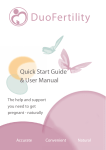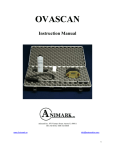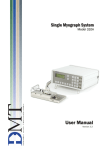Download Thermachoice II (00825) User Manual
Transcript
U.S.A. Distribution /Manufactured for: GYNECARE a Division of ETHICON, INC. a Johnson & Johnson company Somerville, N.J. 08876-0151 USA Tel: 1-877-ETHICON Authorized European Representative: ETHICON GmbH Robert-Koch-Strasse 1 D-22851 Norderstedt Germany Tel: 040/5297-01 EC Legal Manufacturer Gynecare a division of ETHICON, INC. a Johnson & Johnson company Somerville, New Jersey 08876-0151 SYMBOLS USED ON LABELING See instructions for Use CE Mark and identification number of Notified Body. Product conforms to the essential requirements of the Medical Devices Directive 93/42/EEC. Somerville, New Jersey 08876-0151 ©1994, 1995, 1996, GYNECARE *Trademark * GYNECARE THERMACHOICE UBT System Operating Manual CE0123 Somerville, New Jersey 08876-0151 US GB 389614 Table of Contents Page Device Description ..................................................................................................1 Indications ................................................................................................................1 Contraindications ....................................................................................................6 Warnings ....................................................................................................................6 Precautions ................................................................................................................7 Adverse Events ........................................................................................................8 Other Adverse Effects ..............................................................................................8 Clinical Trial ..............................................................................................................9 Patient Population ..................................................................................................10 Patient Selection......................................................................................................14 Patient Counseling ................................................................................................14 Pretreatment Preparation of Patient ....................................................................15 Directions for Use ..................................................................................................15 Set-up ........................................................................................................15 Catheter Priming ......................................................................................19 Pressure Titration ....................................................................................19 Treatment ..................................................................................................21 Post-Treatment..........................................................................................22 Operating Parameters/Alarm and Display Messages ....................................22 Error Messages........................................................................................................23 Warranty ..................................................................................................................24 Servicing/Equipment Disposal ............................................................................25 Ordering Information ............................................................................................25 Specifications (Controller & Umbilical Cable) ..................................................25 Environmental Conditions ....................................................................................26 Electromagnetic Interference ................................................................................26 Maintenance ............................................................................................................26 Calibration ................................................................................................26 Fuse Replacement ....................................................................................28 Cleaning: Controller System ..................................................................28 Disinfection: Umbilical Cable ................................................................29 Power Cord ..............................................................................................29 GYNECARE THERMACHOICE UBT System Operating Manual Somerville, New Jersey 08876-0151 * Thermal Balloon Ablation System Read all directions, precautions and warnings prior to use. This manual provides directions for using the GYNECARE THERMACHOICE Uterine Balloon Therapy (UBT) System. Caution: Federal law (USA) restricts this device to sale by or on the order of a physician with appropriate training. DEVICE DESCRIPTION The GYNECARE THERMACHOICE UBT System is a software-controlled device designed to ablate uterine tissue by thermal energy. The system is comprised of a single-use balloon catheter, a reusable controller, umbilical cable, and power cord. The GYNECARE THERMACHOICE UBT catheters are designed for use only with GYNECARE THERMACHOICE UBT controllers. The balloon catheter is 1) connected to the controller, 2) inserted through the cervix into the uterus, 3) filled with sterile, injectable fluid (plain 5% dextrose in water- D5W) carefully stabilizing the pressure to 160-180mmHg pressure, and 4) activated to thermally ablate endometrial tissue by maintaining a temperature of approximately 87°C (188°F) for 8 minutes. The GYNECARE THERMACHOICE UBT controller is designed to work with 3 different versions of the balloon catheter. They are: a) GYNECARE THERMACHOICE IIIC silicone balloon catheter (version 3.0): This balloon catheter has a fluid circulation mechanism inside the balloon (See Diagram 1). b) GYNECARE THERMACHOICE IIC silicone balloon catheter (version 2.0): This balloon catheter has a fluid circulation mechanism inside the balloon (See Diagram 2). c) GYNECARE THERMACHOICE balloon catheter (version 1.2): This version does not have a fluid circulation mechanism inside the balloon (See Diagram 3). Caution: The GYNECARE THERMACHOICE balloon catheter version 1.2 (only) contains natural rubber latex which may cause allergic reactions. INDICATIONS The GYNECARE THERMACHOICE UBT System is a thermal ablation device intended to ablate the endometrial lining of the uterus in women with menorrhagia (excessive uterine bleeding) due to benign causes for whom childbearing is complete. GYNECARE THERMACHOICE UBT System Operating Manual Page 1 Diagram 1 GYNECARE THERMACHOICE IIIC Single Use Silicone Balloon Catheter with Fluid Circulation (Version 3.0) and Umbilical Cable Depth, sound measurement (cm) Silicone balloon Fluid fill valve (Trumpet valve) Fluid fill port for syringe Catheter umbilical cable connection Heater Circulating element Connection plugs Pressure line Circulation connection Front Panel of Controller Catheter heater temperature display (°C) Umbilical cable Hazard light Intra-balloon pressure display (mmHg) Start button light Start button Message display THERMA CHOICE Uterine Balloon Therapy PRESSURE (mmHg) CIRCULATION PRESSURE LINE TEMPERATURE (°C) TIME (min: sec) UMBILICAL CABLE Total time display (minutes : seconds) Power switch Stop button Connection port for reuseable umbilical cable Connection port for pressure line (pre-attached to single use balloon catheter) Connection port for circulation catheter (pre-attached to single use catheter) NOTE: Remove the plug before connecting the circulation catheter. Fuse Rear Panel of Controller WARNING: RISK OF FIRE, REPLACE FAST BLOW FUSE AS MARKED. CAUTION 2X 1.6A@250V FAST BLOW ATTENTION CAUTION CAUTION MODEL NUMBER SERIAL NUMBER 0123 Manufactured For: GYNECARE a Division of ETHICON, INC. a Johnson & Johnson Company Somerville, NJ 08876-0151 1-877-ETHICON 01511 Rev C Connection port for AC power cord Page 2 100-240V~ 50/60 Hz 1.1A@120V~ 0.55A@240V~ See instruction for use DESCRIPTION OF SYMBOLS Front Panel of Controller Off (power: disconnection from the mains) On (power: connection to the mains) Start Button Stop Button When symbol is illuminated, a hazard condition exists which willautomatically terminate procedure (see ERROR MESSAGES section)—consult Operator ’s Manual for further instruction. An unilluminated symbol indicates normal operating conditions. INSERT CATHETER FILL CATHETER Message Display—displays prompts and error messages WITH D5W Displays pressure inside balloon in mmHg Displays heater temperature inside balloon in °C Displays total running time for preheat and therapy in MINUTES : SECONDS Circulation catheter connection port Rear Panel of Controller (See SPECIFICATIONS for additional information.) Connection port for power cord Location of fuses; type and value rating Equipotentiality Class I Type BF Equipment Cover to be removed by qualified service personnel only CAUTION Danger: Risk of explosion if used in the presence of flammable anesthetics! 0123 CE-Mark and identification number of Notified Body. Product conforms to the essential requirements of the Medical Devices Directive 93/42/EEC. GYNECARE THERMACHOICE UBT System Operating Manual Page 3 Diagram 2 GYNECARE THERMACHOICE IIC Single Use Silicone Balloon Catheter with Fluid Circulation (Version 2.0) and Umbilical Cable Depth, sound measurement (cm) Silicone balloon Fluid fill valve (Trumpet valve) Fluid fill port for syringe Catheter umbilical cable connection Heater Circulating element Connection plugs Pressure line Circulation connection Over pressure relief valve Front Panel of Controller Catheter heater temperature display (°C) Umbilical cable Hazard light Intra-balloon pressure display (mmHg) Start button light Start button Message display THERMA CHOICE Uterine Balloon Therapy PRESSURE (mmHg) CIRCULATION PRESSURE LINE TEMPERATURE (°C) TIME (min: sec) UMBILICAL CABLE Total time display (minutes : seconds) Power switch Stop button Connection port for reuseable umbilical cable Connection port for pressure line (pre-attached to single use balloon catheter) Connection port for circulation catheter (pre-attached to single use catheter) NOTE: Remove the plug before connecting the circulation catheter. Fuse Rear Panel of Controller WARNING: RISK OF FIRE, REPLACE FAST BLOW FUSE AS MARKED. CAUTION 2X 1.6A@250V FAST BLOW ATTENTION CAUTION CAUTION MODEL NUMBER SERIAL NUMBER 0123 Manufactured For: GYNECARE a Division of ETHICON, INC. a Johnson & Johnson Company Somerville, NJ 08876-0151 1-877-ETHICON 01511 Rev C Connection port for AC power cord Page 4 100-240V~ 50/60 Hz 1.1A@120V~ 0.55A@240V~ See instruction for use Diagram 3 GYNECARE THERMACHOICE Single Use Balloon Catheter (Version 1.2) and Umbilical Cable Depth, sound measurement (cm) Latex balloon Fluid fill port for syringe (Soft luer) Fluid fill valve (Trumpet valve) Heater Connection plugs Umbilical cable Pressure line Front Panel of Controller Catheter heater temperature display (°C) Hazard light Intra-balloon pressure display (mmHg) Start button light Start button Message display THERMA CHOICE Uterine Balloon Therapy PRESSURE (mmHg) CIRCULATION PRESSURE LINE TEMPERATURE (°C) TIME (min: sec) UMBILICAL CABLE Total time display (minutes : seconds) Power switch Stop button Connection port for reusable umbilical cable Connection port for pressure line (pre-attached to single use balloon catheter) Connection port for circulation catheter (pre-attached to single use catheter) NOTE: Do not remove the plug. The circulation port is not used for this version of the catheter. Fuse Rear Panel of Controller WARNING: RISK OF FIRE, REPLACE FAST BLOW FUSE AS MARKED. CAUTION ATTENTION 2X 1.6A@250V FAST BLOW CAUTION CAUTION MODEL NUMBER SERIAL NUMBER 0123 Manufactured For: GYNECARE a Division of ETHICON, INC. a Johnson & Johnson Company Somerville, NJ 08876-0151 1-877-ETHICON 100-240V~ 50/60 Hz 1.1A@120V~ 0.55A@240V~ See instructions for use 01511 Rev C Connection port for AC power cord GYNECARE THERMACHOICE UBT System Operating Manual Page 5 CONTRAINDICATIONS The device is contraindicated for use in: • • • • • • A patient who is pregnant or who wants to become pregnant in the future. A patient with a history of latex allergy or who has demonstrated a sensitivity to latex material (for catheter version 1.2 only). A patient with known or suspected endometrial carcinoma (uterine cancer) or pre-malignant change of the endometrium such as unresolved adenomatous hyperplasia. A patient with any anatomic or pathologic condition in which weakness of the myometrium could exist, such as history of previous classical cesarean sections or transmural myomectomy. A patient with active genital or urinary tract infection at the time of procedure (e.g., cervicitis, vaginitis, endometritis, salpingitis, or cystitis). A patient with an intrauterine device (IUD) currently in place. WARNINGS Failure to follow all instructions or to heed any warnings or precautions could result in serious patient injury. • The device is intended for use only in women who do not desire to bear children because the likelihood of pregnancy is significantly decreased following this procedure. There have been reports of women becoming pregnant following this procedure. Pregnancies after ablation can be dangerous for both mother and fetus. • Endometrial ablation using the GYNECARE THERMACHOICE UBT System is not a sterilization procedure. • Patients who undergo endometrial ablation procedures who have previously undergone tubal ligation are at increased risk of developing post ablation tubal sterilization syndrome which can require hysterectomy. This can occur as late as 10 years post-procedure. • Endometrial ablation procedures using the GYNECARE THERMACHOICE UBT System should be performed only by medical professionals who have experience in performing procedures within the uterine cavity, such as IUD insertion or dilation and curettage (D&C), and who have adequate training and familiarity with the GYNECARE THERMACHOICE UBT System. • Endometrial ablation procedures do not eliminate the potential for endometrial hyperplasia, or adenocarcinoma of the endometrium and may mask the physician’s ability to detect or make a diagnosis of such pathology. • The GYNECARE THERMACHOICE III UBT Balloon Catheter is for single use only – do not reuse or resterilize. • Do not treat patients for more than one therapy cycle in a given treatment session because of the potential for transmural injury to the uterus or injury to adjacent viscera. • UTERINE PERFORATION • Uterine perforation can occur during any procedure in which the uterus is instrumented. Use caution not to perforate the uterine wall when sounding the uterus, dilating the cervix or inserting the catheter. • Any of the following indicates possible uterine perforation. Page 6 1. If the catheter can be inserted to a greater depth than was determined by the uterine sound 2. If the pressure cannot be stabilized at 160 – 180 mmHg with a maximum of 30ml of fluid 3. If the pressure drops quickly at any point during the procedure • If a perforation is suspected, THE PROCEDURE SHOULD BE TERMINATED IMMEDIATELY. The physician may elect to perform a diagnostic procedure to confirm perforation. If the physician cannot absolutely rule out perforation, the procedure should be abandoned. • For patients in whom the procedure was aborted due to a suspected uterine wall perforation, a work-up for perforation should be considered prior to discharge. • If a perforation is present, and the procedure is not terminated, thermal injury to adjacent tissue may occur if the heater is activated. • After completing the procedure it is important not to touch the GYNECARE THERMACHOICE Uterine Balloon for the following reasons: - The balloon is covered with blood and body fluids - There are mechanical and electrical parts that could puncture the balloon • Proper care should be taken in disposing of the catheter. PRECAUTIONS • The GYNECARE THERMACHOICE III UBT catheter, controller, and umbilical cable are designed as a system. To ensure proper function, never use other components with the GYNECARE THERMACHOICE UBT System. • A starting pressure of 160 – 180 mmHg is recommended and typically requires 6 – 15 ml of fluid and may require as much as 30 ml. Titration to achieve a stable pressure (no fluctuations greater that ±10 mmHg for at least 30 seconds) prior to activating the heating element is critical to proper functioning of the device. When inserting fluid, do not exceed a pressure of 200 mmHg. Typically, pressure levels decline slowly during the course of the procedure as the uterus relaxes. If a pressure of 160 – 180 mmHg cannot be reached with 30 ml or less of fluid, or if there is a rapid drop in pressure, it is likely there is a uterine perforation. • Rapid loss of pressure during a therapy cycle may indicate a uterine wall defect. Adding additional fluid to the balloon may create (or exacerbate if already present) a uterine wall defect such as a perforation. • Those patients who have undergone endometrial ablation and are later placed on hormone replacement therapy should have progestin included in their regimen in order to avoid the increased risk of endometrial adenocarcinoma associated with unopposed estrogen replacement therapy. • Never add additional fluid during a therapy cycle. • The safety and effectiveness of the GYNECARE THERMACHOICE UBT System has not been fully evaluated in patients: - with large uterine cavities (>30 ml in volume or uterine sound >12 cm) - with small uterine cavities (<2 ml in volume or uterine sound <4 cm) - with submucosal myomas, bicornuate or septate uteri or previous endometrial resection/ablation - undergoing repeat endometrial ablation procedures GYNECARE THERMACHOICE UBT System Operating Manual Page 7 - who are post-menopausal • It has been reported that patients with a severe anteverted retroflexed or laterally displaced uterus are at an increased risk of uterine wall perforation during any intrauterine manipulation. The clinician should use discretion in patient selection. • A false passage can occur during any procedure in which the uterus is instrumented, especially in cases of severe anteverted retroflexed or a laterally displaced uterus. Use caution to insure that the device is properly positioned in the uterine cavity. ADVERSE EVENTS CLINICAL STUDY In a study of 134 women performed with a previous generation balloon catheter (version 1.2) [without the fluid circulation mechanism inside the balloon], the most frequent events that have been reported following completion of the procedure include: • • • • • • • Cramping/pelvic pain – Post-treatment cramping was reported in 91.8% of the patients which ranged from mild to severe as reported during the intra-operative and immediate post-operative period. This cramping will typically last a few hours and rarely continues beyond the first day following ablation. The use of non-steroidal anti-inflammatory drugs (NSAIDs) prior to and following UBT is usually sufficient to manage cramping and pelvic pain. Nausea and Vomiting – Nausea and vomiting were reported for 23.9% of the patients in the immediate hours following the procedure. This may be attributed to general anesthesia, and can be easily managed with medication. Endometritis was reported in 2.1% of patients. All patients responded to a course of oral antibiotics. Post-procedure symptoms such as pain, fever, nausea, vomiting, difficulty with defecation or micturition were reported. Failure of such symptoms to resolve over a reasonable period of time warrants evaluation by appropriate medical personnel. Pregnancy was reported in one patient (0.8%) resulting in a 2-month premature live infant. Pregnancy following endometrial ablation is dangerous to both mother and fetus. Hematometra was reported in 0.6% of patients treated in clinical studies conducted outside of the United States. In all patients, the hematometra was resolved with insertion of a uterine sound. A single perforation of the uterus was reported in a controlled clinical study. OTHER ADVERSE EFFECTS As with all endometrial ablation procedures, serious injury or death can occur. The following adverse effects might be potentially expected or have been reported in association with the use of the GYNECARE THERMACHOICE UBT System: 1. Rupture of the Uterus 2. Thermal Injury to Adjacent Tissue 3. Heated Liquid Escaping Into the Vascular Spaces and/or Cervix, Vagina, Fallopian Tubes, and Abdominal Cavity 4. Electrical Burn 5. Hemorrhage Page 8 6. Infection or Sepsis 7. Perforation 8. Post-ablation-tubal sterilization syndrome – This is a complication following endometrial ablation in women who have also previously undergone tubal ligation. The pathophysiology of this condition is believed to be related to the regeneration of endometrium in the cornual areas of the uterus. Blood from these glands can flow back into the proximal fallopian tubes in cases where the lower uterine segment is extensively scarred. The proximal oviduct becomes filled with blood and fluid causing symptoms similar to those of an ectopic pregnancy. 9. Complications leading to serious injury or death. CLINICAL TRIAL The GYNECARE THERMACHOICE IIIC catheter (version 3.0) and GYNECARE THERMACHOICE IIC catheter (version 2.0) includes an active mechanism for circulation of the D5W within the balloon. The GYNECARE THERMACHOICE catheter (version 1.2) has a passive circulation which is based on convection. The clinical data presented below were obtained using the previous generation noncirculating balloon catheter, however, laboratory testing (ex-vivo experiments conducted on extirpated human uteri) has shown that the active circulation of fluid within the balloon will lead to a more even distribution of heat at the balloon surface, and thereby over the endometrial tissue. Conclusions: In a study performed with a previous generation balloon catheter (version 1.2) [without the fluid circulation mechanism inside the balloon] at twelve, twenty-four, and thirty-six months of follow-up, balloon ablation was demonstrated to be at least as safe (with fewer intra-operative complications and shorter procedure times), and as effective as hysteroscopic rollerball ablation in reducing menstrual bleeding to a clinically acceptable level in menorrhagic women who had completed their childbearing. Furthermore, statistically equivalent and significant reductions in patient-reported dysmenorrhea (mild, moderate, severe menstrual cramps), PMS symptoms (mild, moderate, severe common PMS symptoms), and overall impact of menses on lifestyle (scale of 1-10; 1=none, 10=severe) were experienced by both groups. Purpose: The use of balloon thermal ablation for the treatment of menorrhagia for benign causes in an anatomically normal uterine cavity was compared with rollerball electrosurgical endometrial ablation with regard to safety and effectiveness. The primary effectiveness measure was a validated diary scoring system (adapted from Higham JM, O’Brien PMS, Shaw RW, Assessment of menstrual blood loss using a pictorial chart, Br J Obstet Gynaecol 1990;97:734-9). Success was defined as the reduction of excessive menstrual bleeding to normal flow or less. Secondary endpoints evaluated were overall percent decrease in diary scores and responses from a qualityof-life questionnaire. The endpoints for safety were based on the evaluation of adverse events associated with each procedure, including device-related complications, time of procedure, and type of anesthesia use. Methods: This randomized, prospective, multicenter clinical investigation obtained using the previous generation non-circulating balloon catheter was conducted at 14 sites using investigators highly experienced with hysteroscopic rollerball endometrial ablation. All patients were >30 years old, premenopausal, and had completed childbearing. All had an anatomically normal uterine cavity >4 cm and <10 cm. GYNECARE THERMACHOICE UBT System Operating Manual Page 9 Three months of documented menorrhagia for benign causes was a requirement for inclusion and was confirmed with a diary score of at least 150 points. Endometrial biopsy and pap smear were required to rule out (pre)malignant uterine disease. No uterine thinning medications could be used for three months prior to treatment, and all patients underwent a three-minute suction curettage just prior to treatment. Selection of anesthesia regimen was left to the individual investigators. Treatment success was defined as reduction in menses to a diary score less than or equal to 75 in order to assure a return to eumenorrhea. In the original Higham study, a diary score of 100 had an 86% sensitivity and an 81% specificity for true menorrhagia for benign causes as determined by chemical analysis of the saturated pads. PATIENT POPULATION • • 260 patients in Safety Evaluation Group (134 TC; 126 RB) - 1 aborted RB for uterine perforation - 2 aborted (1 TC; 1 RB) for submucous fibroid - 2 aborted TC for inability to maintain device pressure 255 patients treated with test or control device (131 TC; 124 RB) Baseline demographic, physical exam and gynecological variables were statistically equivalent between the test and control groups with regard to age (TC 40.2 years, RB 40.9 years), race, body mass index, mean baseline diary score (TC 552.5, RB 570) and other parameters. Page 10 Subject Withdrawals - Table Ia Subjects: Entered into study (Intent to Treat Population) Procedure aborted Receiving complete treatment For whom 12-month data not available: Hysterectomy Withdrew GYNECARE THERMACHOICE ROLLERBALL 134 126 3 2 131 124 6 10 2 1 3 4 - 1 daughter’s death - 1 menorrhagia - 1 depression - 1 amenorrhea @ 3 mo. Lost to follow-up 3 3 - 1 diary score 14 - 1 amenorrhea @ 3 mo. - 1 amenorrhea @ 3 mo. - 1 6-mo. diary score 32 - 1 6-mo. diary score 77 For whom 12-month data available: For whom 24-month data not available: Hysterectomy Lost to follow-up 125 114 3 2 1 9 6 3 - 1 yr. hypomenorrhea For whom 24-month data available: 122 For whom 36-month data not available: Repeat Ablation 8 1 Hysterectomy Lost to follow-up 4 105 5 2 - both hypomenorrhea @ 2 yr. Withdrew For whom 36-month data available: 1 114 GYNECARE THERMACHOICE UBT System Operating Manual 100 Page 11 RESULTS EFFECTIVENESS Table Ib. Effectiveness Bleeding Rates shows the success rates for the Intent to Treat Group (134 TC; 126 RB) as based on diary scores at the 1-year follow-up of 75 or less. Success at 24 and 36 months, based on telephone questionnaires, is defined as elimination of bleeding or reduction to light or normal flow. The worst-case scenario is presented whereby each of the discontinued patients (described below in the footnotes) is counted as a "failure" for calculating the values listed in the table. Only the amenorrhea rate at 1 year is statistically significantly different between treatment groups (P ≤ 0.05). Table Ib. Effectiveness Bleeding Rates Intention to Treat Group† GYNECARE THERMACHOICE UBT ROLLERBALL n=134 n=126 Months Post Treatment 12 a 24b 36b 12 a 24b Number of Successful Patients 101 109 106 97 95 94 75.4%* 81.3%* 79.1%* 77.0%* 75.4%* 74.6%* 19 16 17 31 23 27 14.2%** 11.9%* 12.7%* 24.6%* 18.2%* 21.4%* Study Success Rate 36b # of Patients with Amenorrhea (# Patients with diary scores = 0) Amenorrhea Rate (% Patients with diary scores = 0) a - based on diary scores b - based on telephone questionnaires *Not Statistically Significant (P> 0.05) **Statistically Significant (P ≤ 0.05) †See Table 1a for Subject Withdrawals Page 12 Table Ic. Effectiveness Quality of Life presents the quality of Life Questionnaire responses for patients who responded at 12, 24 and 36 months. Patients discontinued prior to the visit (described in Table 1a) were not included in the calculations. There were no statistically significant differences between groups. Table Ic. Effectiveness Quality of Life† GYNECARE THERMACHOICE UBT ROLLERBALL Months Post Ablation 12 24 36 12 24 36 # of Patients Who Responded to Quality of Life Questionnaire 125 122 114 114 105 100 % Patients with anemia pre-treatment (HCT) 29.9% N/A N/A 29.7% N/A N/A % Patients with anemia post-treatment (HCT) 11.6% N/A N/A 10.6% N/A N/A Satisfaction: very satisfied or satisfied 96.0% 95.9% 95.6% 98.2% 98.1% 97.0% % Patients with reduction in dysmenorrhea 70.4% 72.1% 73.7% 75.4% 75.2% 78.0% % Patients unable to work outside the home pre-treatment 39.7% 39.7% 39.7% 41.9% 41.9% 41.9% % Patients unable to work outside the home post-treatment 4.0% 0.8% 2.7% 2.7% 2.9% 1.0% % Patients reporting severe impact on life pre-treatment 70.3% 70.3% 70.3% 78.6% 78.6% 78.6% % Patients reporting severe impact on life post-treatment 3.2% 4.9% 1.8% 1.8% 1.0% 2.0% †See Table 1a for Subject Withdrawals SAFETY Table II. Safety shows there were no intra-operative adverse events and 4 postoperative adverse events in the GYNECARE THERMACHOICE UBT Group (n=134). In the Rollerball Group (n=126) there were 4 intra-operative adverse events and 3 adverse events in the immediate post-operative period. These differences were not statistically significant. The mean procedure time for the TC patients was statistically significantly less than for the RB patients. Table II. Safety GYNECARE THERMACHOICE UBT n=134 ROLLERBALL n=126 Intra-operative adverse events None (0%) Post-operative adverse events 1 post-coital bleeding 3 endometritis 1 UTI (3.7%)* 2 fluid overload 1 cervical laceration 1 uterine perforation (3.2%) 1 endometritis 1 hematometra 1 PATSS 1 (2.4%)* 27.4** 39.6** Mean procedure time(minutes) Procedure time is duration between patient prep and catheter removal 1 PATSS = post-ablation-tubal sterilization syndrome *Not Statistically Significant (P> 0.05) **Statistically Significant (P< 0.05) GYNECARE THERMACHOICE UBT System Operating Manual Page 13 ANESTHESIA REGIMEN Selection of anesthesia regimen was left to the individual investigators. Fewer cases were performed under general anesthesia in the GYNECARE THERMACHOICE UBT group as compared to the Rollerball group. For GYNECARE THERMACHOICE UBT only 53.7% had the procedure under general anesthesia versus 84.1% who had the Rollerball procedure performed using general anesthesia. HYSTERECTOMY There were a total of 22 patients (8 TC; 14 RB) who had a hysterectomy within 3 years after endometrial ablation. Table III. Hysterectomy Reason for Hysterectomy Total* TC (n=134) RB (n=126) Possible Carcinoma (found negative) Menorrhagia/abnormal bleeding 0 3 1 5 Pelvic pain/severe dysmenorrhea 4 6 Endometriosis/ovarian cysts 1 2 8 (8.6%) 14 (11.1%) Total *13 hysterectomies were in patients <40 years (4 TC, 9 RB); 9 hysterectomies were in patients >40 years (4 TC, 5 RB) PATIENT SELECTION Menorrhagia can be caused by a variety of underlying problems including but not limited to, endometrial cancer, myomas, polyps, anovulation, drugs, and dysfunctional uterine bleeding. Patients should always be evaluated to determine the cause of their excessive uterine bleeding before any treatment option is initiated. Consult medical literature relative to various endometrial ablation techniques, indications, contraindications, complications, and hazards prior to the performance of any endometrial ablation procedures. The patient selection criteria are: • • • • • • • Documented diagnosis of menorrhagia for benign causes Completed childbearing Premenopausal Normal pap smear and endometrial biopsy Anatomically normal uterine cavity: standard sonography, saline infusion sonography, hysteroscopy, or hysterosalpingography within 6 months prior to performing GYNECARE THERMACHOICE UBT should be used to rule out submucous fibroids, large polyps, and congenital abnormalities Uterine cavity depth of 4-12 cm Failed or contraindicated medical therapy PATIENT COUNSELING As with any procedure the physician needs to discuss risks, benefits and alternatives with the patient prior to performing endometrial ablation. In addition, the physician should discuss signs and symptoms of potential complications such as bleeding, infection or thermal injury. Page 14 The device is intended for use only in women who do not desire to bear children because the likelihood of pregnancy is significantly decreased following this procedure. Post-procedure pregnancy may be dangerous for both mother and fetus. Patients of childbearing capacity should be counseled that endometrial ablation is not a sterilization procedure and should be provided an appropriate birth control method. Patients with childbearing capacity should be cautioned of the potential complications which may ensue if they should become pregnant. Vaginal discharge is typically experienced during the first few days following ablation and may last as long as a few weeks. Generally, the discharge is described as bloody during the first few days; serosanguinous by approximately one week; then profuse and watery thereafter. PRETREATMENT PREPARATION OF PATIENT The lining of the uterus should be thinned prior to GYNECARE THERMACHOICE UBT. This can be accomplished by timing the menstrual cycle to the early proliferative phase, administering pretreatment drugs such as danocrine or GnRH agonists, or performing suction or sharp curettage immediately prior to performing the endometrial ablation. The optimum pretreatment regimes have not been determined at this time. It is recommended that a non-steroidal anti-inflammatory drug (NSAID) be given at least one hour prior to treatment and continued post-operatively as necessary to reduce intra-operative and post-operative uterine cramping. DIRECTIONS FOR USE Please read all directions, precautions and warnings prior to use. 1.0 SET-UP 1.1 The following items are required for use of the GYNECARE THERMACHOICE UBT System. GYNECARE THERMACHOICE UBT System • 1 sterile disposable balloon catheter (see catheter version matrix below) and syringe (30 ml) • 1 umbilical cable • 1 controller • 1 power cord Catheter Version 3.0 Circulation catheter Silicone balloon Catheter Version 2.0 Circulation catheter Silicone balloon Catheter Version 1.2 Non-circulation catheter Latex balloon GYNECARE THERMACHOICE UBT System Operating Manual Has fluid circulation mechanism inside the balloon Has fluid circulation mechanism inside the balloon Does not have fluid circulation mechanism Page 15 Medical Supplies • 50 ml sterile injectable plain 5% dextrose in water (D5W) • tenaculum (weighted) speculum • uterine sound, cervical dilator(s) • sterile drape for umbilical cord (optional) Note: Use only plain D5W to inflate balloon catheter - never use any other fluid. 1.2 Open the sterile package containing the GYNECARE THERMACHOICE UBT Catheter and Syringe. Disinfect umbilical cable as described at the end of this manual. 1.3 Make sure that the controller power is off before making the connection (Steps 1.4 – 1.6). 1.4 Plug the power cord into the back of the controller and into the wall outlet. 1.5 The umbilical cable includes a connector plug at each end to connect the balloon catheter to the controller. Visually inspect the cable and connector plugs to ensure there are no defects or signs of wear. Drape umbilical cable with sterile drape, if necessary, and attach cable to the connector on the catheter umbilical cable connection (for catheters version 3.0 and 2.0) or at the end of the balloon catheter for version 1.2 (match arrows on umbilical cable to notch on catheter). Attach the opposite end of the cable to the connection port on the front panel of controller. (Align red dots from umbilical cable to controller). (See Diagram 4 for circulation catheter versions 3.0 and 2.0 and Diagram 5 for non-circulation catheter version 1.2). Page 16 Diagram 4 GYNECARE THERMACHOICE IIIC Silicone Balloon Catheter with Fluid Circulation (Version 3.0) Catheter umbilical cable connection Controller Match arrows together* Detail “A ” Remove the plug before connecting the circulation catheter Align red dots from umbilical cable to controller Umbilical cable Detail “B ” Circulation catheter connection Pressure line filter (Ensure a snug connection) GYNECARE THERMACHOICE IIC Silicone Balloon Catheter with Fluid Circulation (Version 2.0) Catheter umbilical cable connection Controller Match arrows together* Detail “A ” Remove the plug before connecting the circulation catheter Align red dots from umbilical cable to controller Umbilical cable Detail “B ” Circulation catheter connection Pressure line filter (Ensure a snug connection) GYNECARE THERMACHOICE UBT System Operating Manual Page 17 Diagram 5 GYNECARE THERMACHOICE Catheter (Version 1.2) Match arrows on umbilical cable to notch on catheter* Detail “A ” Do not remove plug. The circulation port is not used for this version of the catheter. Controller Align red dots from umbilical cable to controller Pressure line filter (Ensure a snug connection) Detail “B ” 1.6 Connect the pressure line (pre-attached to balloon catheter) to the connection port (luer lock) on the front panel of controller. Do not overtighten, but ensure a snug connection or the device may not function properly. (See Diagram 4-5). Periodically clean the entrance of the controller’s port, using a cotton swab with 50% isopropyl alcohol. Ensure that the pressure line is fully connected prior to adding any fluid to the system. 1.7 Use this step for the GYNECARE THERMACHOICE IIC and IIIC silicone balloon catheter with fluid circulation (version 2.0 and version 3.0) only. Remove the plug from the circulation catheter port. To remove the plug, press on the locking latch and pull the plug. Save the plug. It should be reinstalled when the controller is not in use. Connect the circulation catheter plug into the circulation port. It will lock in place with a slight click. Make sure it’s locked in by slightly pulling on it. 1.8 TURN ON the controller POWER. The Message Display will read: Message Display: Note: N.NN = software revision level REVISION N.NN INITIALIZING Message Display: CONNECT CATHETER Once catheter is connected, the Message Display will read: PRIME CATHETER The pressure line MUST be connected to the controller BEFORE the balloon catheter is filled with fluid, or the device will not function properly. Page 18 2.0 CATHETER PRIMING 2.1 FILL the 30 ml syringe with approximately 5-10 ml (consistency w/2.4) of sterile injectable 5% dextrose in water (D5W). Use only sterile injectable 5% dextrose in water (D5W). Use of other fluids may compromise system. 2.2 CONNECT the syringe to the port in the proximal end of the balloon catheter. Do not overtighten syringe when connecting. 2.3 Point balloon catheter tip downward. 2.4 Press trumpet valve on top of balloon catheter handle and slowly fill with 5-10 ml of D5W. Ensure that the pressure does not go above 200 mmHg indicated by the pressure display on the controller. 2.5 Press trumpet valve and evacuate fluid and air from balloon to a negative pressure of –150 to –200 mmHg (indicated by pressure display on controller). Note: You may need to purge air from syringe several times to attain desired negative pressure. You must release trumpet valve to maintain negative pressure. Air should be completely evacuated to optimize the function of the device. During priming, when catheter pressure is <-150 mmHg, the Message Display is: PRIME CATHETER <-150 mmHg DO NOT EXCEED - 200 mmHg negative pressure during evacuation. 2.6 The negative pressure creates a low-profile balloon insertion (balloon is drawn tight against catheter tip). Do not go beyond –200 mmHg. Check that negative pressure is maintained for at least 10 seconds before proceeding. Once catheter pressure is >-150 mmHg, the Message Display is: INSERT CATHETER & FILL WITH D5W If negative pressure cannot be maintained for 10 seconds, remove the balloon catheter and replace. 3.0 PRESSURE TITRATION 3.1 Fill syringe to 30 ml with D5W, purge air, and connect to balloon catheter (do not overtighten). Do not use more than 30 ml of D5W. 3.2 Measure depth of uterus. 3.3 Using appropriate sterile technique and cervical/vaginal preparation, dilate cervix to 5 mm if necessary. If a perforation is suspected at this point, perform appropriate diagnostic measures to evaluate for perforation before proceeding. If perforation can not be ruled out, abandon the procedure. 3.4 Wet the outside of balloon with D5W. 3.5 After sounding the uterus, and wetting the balloon, SLOWLY INSERT THE BALLOON CATHETER into the uterus until the tip is touching the fundus. Ensure that the depth indicated by markings on catheter is consistent with GYNECARE THERMACHOICE UBT System Operating Manual Page 19 previous sound measurement. Use a tenaculum to hold the cervix if necessary. 3.6 Ensure that the cervix is dilated to 5mm and do not use excessive force during insertion, as such force can cause the balloon to tear or the catheter to perforate the uterine wall. If a perforation is suspected at this point, perform appropriate diagnostic measures to evaluate for perforation before proceeding. If perforation can not be ruled out, abandon the procedure. 3.7 Press trumpet valve on top of balloon catheter and fill balloon slowly to pressure of 160-180 mmHg using 2-30 ml of D5W (Release the trumpet valve to allow the pressure to stabilize). Do not allow the pressure to exceed 200 mmHg during titration. Incrementally add small volumes to achieve a stable pressure (no fluctuations greater than +10 mmHg) of 160-180 mmHg for a minimum of 30 seconds. The pressure of the balloon against the uterine wall often precipitates uterine contraction, thereby temporarily increasing the pressure reading. If pressure cannot be stabilized at 160-180 mmHg for 30-45 seconds with 30 ml of fluid, this may indicate uterine perforation. Remove the balloon catheter. If a balloon leak is present, replace the catheter and continue with the procedure. If no balloon leak is found, perform appropriate diagnostic measure to evaluate for perforation before proceeding. If perforation cannot be ruled out, abandon the procedure. Note: Once the heater is activated, the pressure may initially rise 10-20 mmHg; the pressure may then drop slowly for the remainder of the procedure. The ending balloon pressure may be as low as approximately 100 mmHg, and is typically between 120-150 mmHg. Note: It is recommended that for very small uteri, pressure titration should occur towards the lower end of the range (i.e. Use a minimum amount of fluid to reach 160 mmHg. This will reduce the potential for increase of pressure during the thermal treatment that might result in overpressure and system shutdown). Note: Positioning the device in a false passage may allow the balloon to reach operating pressure with a small amount of fluid. This may be misinterpreted as being a small uterine cavity. Care should be taken to insure the device is properly positioned in the uterine cavity. Do not over pressurize balloon during titration. Optimal balloon volume depends on the potential volume of the uterine cavity and is typically 6-15 ml at >160 mmHg (at start) and may be as great as 30 ml. If pressure level cannot be reached with 30 ml of fluid, remove balloon catheter and check for uterine perforation and/or balloon catheter leak. Replace balloon catheter if necessary. Page 20 4.0 TREATMENT 4.1 Message Display (alternating): READY PRESS START and STABILIZE START PRESSURE >150 When a steady pressure of 160-180 mmHg is maintained, press START ( button on controller to activate the heater. ) Do not add fluid once heater is activated, as this could create (or exacerbate if already present) a uterine wall defect such as perforation. Hold the balloon catheter immobile and centered in the uterine cavity during procedure (with the valve oriented upwards). Failure to hold the balloon catheter immobile during procedure can result in catheter failure. Note: Ensure that the balloon catheter is centered in the uterus to minimize potential overheat error codes during the treatment process. 4.2 After the start button is pressed, the controller activates the heater to achieve treatment temperature of 87°C (188°F) within 4 minutes. (This preheat cycle may take up to 4 minutes for larger uteri, but is usually 15-45 seconds). PREHEATING TO 87°C Note: If the treatment temperature of 87°C is not reached within 4 minutes, the controller will terminate the procedure. Remove the fluid, remove the catheter. ) button can be Note: During treatment and in case of emergency, the STOP ( pressed to terminate the procedure. The stop button will power down the heater and the heater function can only be resumed by turning the unit off and restarting. 4.3 Message Display: THERAPY CYCLE 87°C, 8 MIN Once 87°C is reached, an audible tone will indicate the automatic activation of the 8 minute therapy cycle. The Time elapsed will be shown on the “THERAPY TIME” display. After the preheat cycle is completed the time resets to 0:00. The displayed time represents the exact therapy cycle time. Note: Pressure may rise slightly with initial heating. It is common to then see the pressure fall gradually during procedure. If the pressure reaches 200 mmHg, an alarm will sound. If the pressure exceeds 210 mmHg for more than 2 seconds, the controller will terminate the procedure. The procedure may be restarted with a lower starting pressure to complete an 8 minute therapy. Note: A rapid drop in pressure or a failure to maintain pressure may be the result of a catheter leak or uterine perforation. After sufficient cooling, remove the balloon catheter. A work-up for perforation should be considered prior to discharge. GYNECARE THERMACHOICE UBT System Operating Manual Page 21 Note: Never add additional fluid during a therapy cycle as this could create (or excerbate if already present) a uterine wall defect such as a perforation. 4.4 When the treatment cycle is completed, the Message Display will alternate between the following messages: THERAPY COMPLETED and COOLING DOWN PLEASE WAIT 4.5 The controller automatically terminates the heater at the end of the treatment (cycle) and an audible alarm will sound. 5.0 POST-TREATMENT 5.1 The cool down cycle takes 30 seconds. When the cycle is completed, the Message Display will read the following: THERAPY & COOL DOWN COMPLETED then REMOVE FLUID REMOVE CATHETER Remove fluid by drawing back on syringe while depressing trumpet valve. Remove all fluid from balloon. Remove the balloon catheter. Check that the entire fluid volume is withdrawn. 5.2 Disconnect the catheter pressure line from the controller. 5.3 Disconnect the circulation catheter plug, if applicable, from the controller. 5.4 Disconnect the umbilical cable from the catheter (for version 1.2) or from the catheter umbilical cable connection (for versions 3.0 and 2.0) by pulling back the gray collar. 5.5 Disconnect the umbilical cable from the controller by holding the stainless steel ribbed shell and pulling back. Do not pull on the cable itself. 5.6 Discard the catheter. Retain the umbilical cable and disinfect for the next case. 5.7 Power must be turned off before beginning another procedure. Note: When a controller is left on without use for 8 hours, the controller freezes and displays the following message: MAX TIME EXPIRED TURN POWER OFF OPERATING PARAMETERS / ALARM AND DISPLAY MESSAGES The controller is designed to monitor time, temperature and pressure within parameters present at the factory. • • ALERT. If the temperature and/or pressure increases or falls beyond a level preset at the factory, the controller will sound a short audible alarm. HAZARD ALARM/TERMINATION OF PROCEDURE (HEATER SHUT OFF LIMITS). If the temperature and/or pressure increase or falls outside the operating parameters, the controller will sound an alarm, terminate the procedure and display an error message. Additionally, if the controller detects a system Page 22 failure, the procedure will be terminated. If the procedure is terminated, the Message Display will display a message indicating the cause. The following chart explains operating parameters for temperature, time, and pressure: Standard Temperature 87°C Range 75-90°C Alarm/Heater Over Under Pressure 70-210 mmHg Titrate to 160-180 mmHg before starting procedure; activation pressure (minimum starting pressure) >150 mmHg Time Shut-off Limits >95°C for 2 seconds or between 90-94°C for 15 seconds <75°C for 15 seconds* Over >210 mmHg for 2 seconds Under <70 mmHg for 2 seconds Over >4 minute pre-heat 8-minute therapy cycle after reaching 87°C (preheat phase) *or failure to achieve temperature of 87°C within 4-minute preheat phase When parameters extend outside the normal operating range, the controller sounds an audible alarm (intended only as a warning signal to the clinician). These values are listed below and reside between normal operating parameters (see previous chart): Temperature Pressure Over Under Over Under Alert (Warning) >90°C & <95°C for 2 seconds <83°C for 2 seconds >200 mmHg & <210 mmHg for 2 seconds >70 mmHg & <100 mmHg for 2 seconds ERROR MESSAGES Under electrostatic discharge to the controller or abnormal line voltage conditions, i.e., surge and fast transients, the system may reset to the initial power-up state. It is also possible that the unit may terminate the procedure with an error code. In this case, turn off the power to the controller and restart the procedure. In addition to the operating messages listed in the "Directions," the message Display also provides messages which indicate conditions under which the controller either will not begin treatment or will terminate treatment after the heating cycle has been initiated. GYNECARE THERMACHOICE UBT System Operating Manual Page 23 Prior to pressing START ( ) – The following error messages indicate conditions under which the controller will not begin therapy cycle until corrected: MESSAGE DISPLAY CONNECT CATHETER REASON Balloon catheter and/or umbilical ACTION Connect balloon catheter. Ensure connections are secure. Once connected, if message persists,replace catheter and/or umbilical cable. CATHETER ERROR REPLACE CATHETER Balloon catheter and/or umbilical cable is not functioning properly. Replace balloon catheter and/or umbilical cable. SYSTEM ERROR TURN POWER OFF System is not functioning properly. Return controller for repair. After pressing START ( ) – The following error messages indicate conditions under which the controller will terminate the procedure and disable the heating element after the therapy cycle has begun: MESSAGE DISPLAY CATHETER ERROR END PROCEDURE REASON Balloon catheter is not functioning properly. ACTION Remove fluid. Remove balloon catheter. SYSTEM ERROR or HEATER ERROR and END PROCEDURE System is not functioning properly. Remove fluid. Remove balloon catheter. Return controller for repair. PREHEAT ERROR or OVERHEAT ERROR or UNDERHEAT ERROR or PRESSURE ERROR and END PROCEDURE Treatment temperature and/or pressure is outside standard operating parameters. Remove fluid. Remove balloon catheter. WARRANTY GYNECARE, a Division of ETHICON, INC., warrants to the original purchaser of the GYNECARE THERMACHOICE UBT System Controller that it shall be free of defects in material and workmanship when used as intended under normal surgical conditions and in conformance with its directions for use and maintenance instructions. The obligation of GYNECARE under this warranty shall be limited to the repair or replacement, each at no charge, at the option of GYNECARE within one year from the date of purchase, if examination shall disclose to the satisfaction of GYNECARE that the controller does not meet this warranty. THIS WARRANTY IS MADE IN LIEU OF ALL OTHER WARRANTIES EXPRESSED OR IMPLIED INCLUDING THE WARRANTIES OF MERCHANTABILITY AND FITNESS FOR USE AND ALL OTHER OBLIGATIONS AND LIABILITIES ON THE PART OF GYNECARE. GYNECARE NEITHER ASSUMES NOR AUTHORIZES ANY OTHER PERSON TO ASSUME FOR IT, ANY OTHER LIABILITY IN CONNECTION WITH THE SALE OF A GYNECARE CONTROLLER. THIS WARRANTY SHALL NOT APPLY TO A GYNECARE CONTROLLER OR ANY PART THEREOF WHICH HAS BEEN SUBJECT TO ACCIDENT, NEGLIGENCE, ALTERATION, ABUSE, OR MISUSE, NOR TO ANY GYNECARE CONTROLLER THAT HAS BEEN REPAIRED OR ALTERED BY ANYONE OTHER THAN AN AUTHORIZED GYNECARE SERVICE PERSON. GYNECARE MAKES NO WARRANTY WHATSOEVER WITH REGARD TO Page 24 ACCESSORIES OR PARTS USED IN CONJUNCTION WITH THE GYNECARE CONTROLLER AND NOT SUPPLIED AND MANUFACTURED OR INSTALLED BY GYNECARE THE TERM "ORIGINAL PURCHASER", AS USED IN THE WARRANTY, SHALL BE DEEMED TO MEAN THAT PERSON OR ORGANIZATION AND ITS EMPLOYEES, IF APPLICABLE, TO WHOM THE GYNECARE CONTROLLER WAS SOLD BY GYNECARE THIS WARRANTY MAY NOT BE ASSIGNED OR TRANSFERRED IN ANY MANNER. GYNECARE shall in no event be liable for any special, indirect or consequential damages of any kind and however caused arising from the sale or use of the UBT system. Should any GYNECARE controller become inoperable after the one year period of this Warranty or should damage occur which is not covered under the terms of this Warranty, GYNECARE will, upon request, repair the controller, if possible, for an appropriate handling and repair charge. SERVICING / EQUIPMENT DISPOSAL Should the GYNECARE THERMACHOICE UBT System controller become inoperable, contact your local sales representative. Clean and repackage the controller appropriately and return it for repair, servicing and/or modification to JaBil Global Services Inc., 11201 Electron Drive, Louisville, KY 40299 (US customers only) or your local GYNECARE authorized service center. If the controller is not under warranty, an appropriate handling and repair charge will be established after receipt and examination of the controller. Note: The GYNECARE THERMACHOICE UBT System controller contains electronic printed circuit assemblies. At the end of the useful life of the equipment, it should be disposed of in accordance to any applicable national or institution related policy relating to obsolete electronic equipment. Note: Dispose of any system accessories according to normal institution practice relating to potentially contaminated items. Note: Any device related incident or problems which are felt to represent a safety issue should be reported by calling GYNECARE at 1-877-ETHICON. ORDERING INFORMATION For ordering information call 800-255-2500. SPECIFICATIONS (CONTROLLER & UMBILICAL CABLE) POWER SOURCE (Controller) Power Requirements............................100 to 240 VAC; 50/60 Hz; 110 watts; 3-wire grounded system Regulation Voltage ..............................90 to 264 VAC, 47-63 Hz, single phase Mains Fuses ..........................................250 VAC, 5 x 20 mm 1.6 A standard MECHANICAL CHARACTERISTICS Dimensions............................................Height 10.2 cm (4 in.), width 41.2 cm (16.25 in.), depth 37.0 cm (14.56 in.) Weight ....................................................6.9 kg (15.3 lbs) (controller only) Case ........................................................Aluminum and impact-resistant plastic Umbilical Cable ....................................Length 152 cm (60 in.) GYNECARE THERMACHOICE UBT System Operating Manual Page 25 ENVIRONMENTAL CONDITIONS Transport and Storage Ambient temperature ..........................-20 to +50°C Relative humidity ................................20% to 85% non-condensing Operation Ambient temperature ..........................10 - 40°C Relative humidity ................................20% to 85% non-condensing Electromagnetic Compatibility ESD ........................................................Direct & Indirect: Conforms to IEC 601-1-2 EMI ........................................................Conforms to IEC 601-1-2 Leakage Currents Patient Leakage Current......................Conforms to IEC 601-1 Earth Leakage Current ........................Conforms to IEC 601-1 ELECTROMAGNETIC INTERFERENCE In general, sensitive electronic equipment should always be positioned as far away as possible from sources of high frequency voltages and currents, such as electrosurgical generators. Moreover, cables connected to high frequency sources should be kept as short as possible and must never be routed near or parallel to cables of sensitive equipment. MAINTENANCE 1.0 CALIBRATION Every time the GYNECARE THERMACHOICE UBT System is powered up, the controller checks the calibration of the temperature circuitry. The pressure measurement in the system is accomplished by utilizing two transducers. These transducers are internally calibrated and are temperature compensated which are accurate and stable over the operating range. They are also factory calibrated at installation. These pressure readings are checked against each other at power up and throughout the procedure. These sensors are of differential type, and therefore measure the balloon pressure relative to the outside atmosphere. In addition to the internal means of calibration, it is possible to ensure the proper operation of the system against other calibrated devices. The procedure is recommended to be performed on an annual basis. The procedure also needs to be carried out if it is believed that the system is behaving unexpectedly. Note: There are no calibration adjustments on the controller. If the unit does not meet the calibration requirements, it needs to be sent back to the manufacturer. 1.1 PRESSURE CALIBRATION 1.1.1 Equipment List The following equipment list or equivalent is needed to perform the procedure: 1. Pressure meter: DigiMano model DPM 2000PS. NETECH Corporation, 60 Bethpage Drive, Hicksville, NY 11801, Telephone: (800) 547-6557/(Any calibrated NBS traceable pressure gauge with a range of at least +6 psi can be used). 2. Syringe: PN 3099650, Becton-Dickinson, McKesson General Medical, 4501 Pell Drive, Sacramento, CA 95838, Telephone: (800) 366-8990. Page 26 3. 4. 5. 6. Trumpet valve: PN S5402601, Braun Medical, Inc., 824 Twelfth Ave., PO Box 027, Bethlehem, PA 18018-0027, Telephone: (800) 227-2862. T connector: PN T20-1, Value Plastics, Inc., 3350 Eastbrook Dr., Fort Collins, CO 80525, Telephone: (970) 223-8306. Tubing: 0.093 ID, 0.156 OD, Norton Performance Plastics Corp, PO Box 660, Akron, OH 44309-3660, Telephone: (800) 798-1539. Male luer lock adapter: PN B0850402, Braun Medical, Inc., 824 Twelfth Ave., PO Box 4027, Bethlehem, PA 18018-0027, Telephone: (800) 227-2862. Diagram 6 Syringe Trumpet valve 1.1.2 Male luer lock adapter T-Connector Pressure gauge Procedure 1. With no attachments to the luer lock, apply power to the controller. The pressure display should read 0+10 mmHg. 2. Assemble the digital pressure gauge, the tubing, the T connector, the trumpet valve, the male luer lock adapter, and the syringe as shown in Diagram 6, and connect to the connection port (luer lock) of the controller. 3. While depressing the trumpet valve, apply vacuum to the system using the syringe until the gauge reads approximately –250 mmHg. 4. Release the trumpet valve. The controller pressure reading should be within +10 mmHg of the gauge reading 5. While depressing the trumpet valve, apply pressure to the system until the reading on the digital display meter indicates a pressure of approximately 250 mmHg. 6. Release the trumpet valve. The controller pressure reading should be within +10 mmHg of the gauge reading. 1.2 TEMPERATURE CALIBRATION 1. 2. 3. 4. 5. Obtain a calibrated digital or glass thermometer. Place this thermometer in close proximity to a new GYNECARE THERMACHOICE UBT catheter tip and allow them to come to thermal equilibrium with the ambient. Connect the catheter to the controller using the umbilical cable as described earlier in the manual. Power up the controller. Note the thermometer reading and compare to that of the controller. The readings should be within +5 degrees Celsius. GYNECARE THERMACHOICE UBT System Operating Manual Page 27 6. Insert the balloon end of the catheter along with the thermometer in 80-90 degrees Celsius water. 7. Allow a few minutes for the catheter and the thermometer to come to thermal equilibrium. 8. Compare the two temperature readings. They should be within +5 degrees Celsius. 2.0 FUSE REPLACEMENT Fuse: In the event of a main fuse failure, turn off the power and unplug the rear of the controller to allow fuse access. Using a tool such as a screwdriver, remove the fuse drawer by depressing the locking tab. See Diagram 7 below: Diagram 7 Mains Fuse Drawer Use a tool to depress the locking tab Mains Fuse type and rating Replace both fuses with the same type and rating as specified on the rear of the controller. Reinsert the fuse drawer until the locking tab snaps into place. Reconnect the power cord and restore power to the controller. If a fuse fails again, disconnect all power to the controller and return it to GYNECARE. All other service must be performed by appropriately qualified technical personnel. Field repair, other than the controller’s external fuse replacement, voids all warranties and may not be performed without express authorization from GYNECARE. 3.0 CLEANING: CONTROLLER SYSTEM It is good practice to routinely clean the exterior surface of the device. 1. Disconnect all umbilical cables and unplug the power cord from the wall outlet before cleaning. 2. Use a cloth dampened with 50% water and 50% isopropyl alcohol, or a mild, nonabrasive detergent (such as commercially available dish cleaning liquid) mixed with water. 3. Periodically clean the entrance of the controller’s port (luer lock) using a cotton swab with 50% isopropyl alcohol. Do not autoclave, ETO sterilize, or immerse the controller or umbilical cable in a liquid. Do not allow liquids to enter the controller during cleaning. Page 28 4.0 DISINFECTION: UMBILICAL CABLE The GYNECARE THERMACHOICE UBT umbilical cable is packaged non-sterile. After each use, the cable should be disinfected. To disinfect, wipe down the cable with a damp cloth using a solution of 50% water and 50% isopropyl alcohol. Use only 50% water and 50% isopropyl alcohol. Ensure the cable and connectors are completely dry. Inspect the cable and the connector plugs before each use for signs of wear and replace if necessary. The umbilical has been validated for 20 cycles. Following 20 uses, discard the cable, and replace. 5.0 POWER CORD Users in North America operating from a nominal 120 VAC system must select a Type SJT, SJTO, SJO, or SJE, Hospital Grade cord set. The power supply cord must be marked "Grounding Reliability can only be achieved when the equipment is connected to an equivalent receptacle marked ‘Hospital Grade’ or ‘Hospital Only.’" GYNECARE THERMACHOICE UBT System Operating Manual Page 29 Error Code Table ERROR CODE 01 DISPLAYED TEXT SYSTEM ERR01XX TURN POWER OFF 02 REASON Controller malfunction ACTION Turn power switch off and REMOVE CATHETER then on again. If error message persists,return to GYNECARE for service. SYSTEM ERR02XX TURN POWER OFF Controller malfunction Turn power switch off and then on again. If error message persists,return controller to GYNECARE for service. 03 SYSTEM ERR03XX TURN POWER OFF Controller malfunction Turn power switch off and then on again. If error message Gynecare for service. persists, return controller to GYNECARE for service. 50 CATHETER ERR50XX REPLACE CATHETER Catheter malfunction Possible catheter failure. Turn power off to clear error message and replace catheter. 51 CATHETER ERR51XX REPLACE CATHETER Catheter malfunction Possible catheter failure. Turn power off to clear error message and replace catheter. 52 CATHETER ERR52XX REPLACE CATHETER —————————— REMOVE FLUID REMOVE CATHETER Catheter malfunction Possible catheter failure. Turn power off to clear error message and replace catheter. 53 OVERHEAT ERR53XX END PROCEDURE Fluid temperature between 90 °C 95 °C for 15 seconds. Return controller to GYNECARE and for service. 54 CATHETER ERR54XX END PROCEDURE —————————— REMOVE FLUID REMOVE CATHETER Fluid temperature >95 °C for 2 seconds. Return controller to GYNECARE for service. 55 CATHETER ERR55XX END PROCEDURE —————————— REMOVE FLUID REMOVE CATHETER Catheter malfunction Possible catheter failure. Turn power off to clear error message and replace catheter. Page 30 Error Code Table 56 CATHETER ERR56XX END PROCEDURE —————————— REMOVE FLUID REMOVE CATHETER Catheter malfunction Possible catheter failure. Turn power off to clear error message and replace catheter. 57 CATHETER ERR57XX END PROCEDURE —————————— REMOVE FLUID REMOVE CATHETER Catheter malfunction Possible catheter failure. Turn power off to clear error message and replace catheter. 58 CATHETER ERR58XX END PROCEDURE —————————— REMOVE FLUID REMOVE CATHETER Catheter malfunction Possible catheter failure. Turn power off to clear error message and replace catheter. 59 OVERHEAT ERR59XX END PROCEDURE —————————— REMOVE FLUID REMOVE CATHETER Fluid temperature between 90 °C and 95 °C for 15 seconds. Return controller to GYNECARE for service. 60 OVERHEAT ERR60XX END PROCEDURE —————————— REMOVE FLUID REMOVE CATHETER Fluid temperature >95 °C for 2 seconds. Return controller to GYNECARE for service. 61 OVERHEAT ERR61XX END PROCEDURE —————————— REMOVE FLUID REMOVE CATHETER Fluid temperature >105 °C for 2 seconds. Return controller to GYNECARE for service. 62 PRESSURE ERR62XX END PROCEDURE —————————— REMOVE FLUID REMOVE CATHETER Under-pressure: Possible catheter failure -leak. Turn power off to clear error PRESSURE ERR63XX END PROCEDURE —————————— REMOVE FLUID REMOVE CATHETER Over-pressure: 64 HEATER ERR64XX END PROCEDURE —————————— REMOVE FLUID REMOVE CATHETER Fluid temperature <87 °C during entire 4 minute preheat cycle. Return controller to GYNECARE for service. 65 HEATER ERR65XX END PROCEDURE —————————— REMOVE FLUID REMOVE CATHETER Catheter malfunction Possible catheter failure. Turn power off to clear error message and replace catheter. 63 Pressure <70 mmHg for 2 seconds. Turn power off to clear error. Pressure >210 mmHg for 2 seconds. GYNECARE THERMACHOICE II System Operating Manual Page 31 Error Code Table 66 UNDERHEAT ERR66XX END PROCEDURE —————————— REMOVE FLUID REMOVE CATHETER Fluid temperature <75 °C for 15 seconds. Return controller to GYNECARE for service. 67 UNDERHEAT ERR67XX END PROCEDURE —————————— REMOVE FLUID REMOVE CATHETER Pressure transducer Return controller to GYNECARE for service. 68 CATHETER ERR68XX END PROCEDURE —————————— REMOVE FLUID REMOVE CATHETER Fluid temperature did not rise ~6 °C within 30 seconds. Possible catheter failure.Turn power off to and replace catheter. clear error message Page 32 This page has been left blank intentionally. GYNECARE THERMACHOICE II System Operating Manual Page 33







































